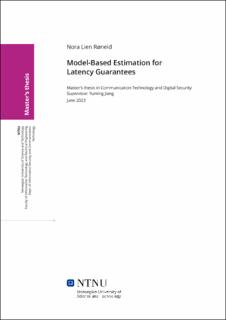| dc.contributor.advisor | Jiang, Yuming | |
| dc.contributor.author | Røneid, Nora Lien | |
| dc.date.accessioned | 2023-09-08T17:19:36Z | |
| dc.date.available | 2023-09-08T17:19:36Z | |
| dc.date.issued | 2023 | |
| dc.identifier | no.ntnu:inspera:146715749:35266957 | |
| dc.identifier.uri | https://hdl.handle.net/11250/3088387 | |
| dc.description.abstract | Mange nye teknologier innen kommuniserende nettverk setter strenge krav til forsinkelsen på kommunikasjonen. Det kreves garantier på at forsinkelseskravene kan holdes for at teknologiene skal kunne fungere slik de er tenkt. Dette er viktig for å kunne unngå situasjoner som at selvkjørende biler krasjer, at fjernkirurgi går galt og at videosamtaler oppleves hakkete og trege. Denne masteravhandlingen undersøker hvorvidt analytiske modeller kan benyttes for å garantere og forutse forsinkelsene i et nettverk gjennom sammenlikning med resultater generert ved hjelp av simuleringer av nettverket. I nyere tid er det gjort lite forskning på om disse modellene fremdeles er gjeldende.
For å kunne undersøke om de analytiske modellene kan brukes for å garantere forsinkelseskrav må først en litteraturstudie av modellene bli gjort. Videre må en simuleringsplattform utvikles for å kunne generere resultatene modellenes resultater skal sammenliknes med. Til slutt må resultatene sammenliknes ved hjelp av grafiske verktøy.
Gjennom denne studien er det funnet ut at de fleste resultater fra de analytiske modellene stemmer godt overens med resultatene generert av simulatoren. Noen modeller avviker mer fra de simulerte resultatene enn andre og er for optimistiske om hvor mye forsinkelser som vil oppstå i systemet. Modellene kan bestå av både eksakte og tilnærmede resultater, men det er generelt ikke dette som avgjør hvor godt resultatene stemmer overens. Det er nødvendig å være obs på om belastningsnivået på systemet endres over tid da dette vil påvirke resultatene, spesielt i overgangsfaser mellom ulike belastningsnivåer. | |
| dc.description.abstract | Many new technologies within communication networks have strict requirements when it comes to the latency of the communication within the network. There are latency requirements that have to be guaranteed to make sure that the technologies can work as intended. This is important to be able to avoid situations such as self-driving cars ending up in a crash, having remote surgeries go wrong, and having video calls being experienced as choppy and slow. This Master's thesis investigates whether or not analytical models can be used for guaranteeing and predicting the latency within a network through comparisons to results generated by a simulation of the network. There has not been a lot of research in recent years on whether or not these models are still applicable.
There is a need to do a literature study to be able to investigate if the analytical models can be used for guaranteeing latency requirements or not. A simulation platform also has to be developed to be able to create results that the model's results can be compared to. Lastly, graphical tools are needed to be able to compare the results of the two.
Through this study, it was discovered that most of the results of the analytical models compare well to the results generated by the simulator. Some models deviate more from the simulated results than others and appear too optimistic about how much latency will be present in the system. The models can consist of both exact and approximated results, but in general this is not what decides how well the results are lining up. It is necessary to be aware of if the load level on the system is changing over time as this will affect the results, especially in the phase between two load levels. | |
| dc.language | eng | |
| dc.publisher | NTNU | |
| dc.title | Model-Based Estimation for Latency Guarantees | |
| dc.type | Master thesis | |
